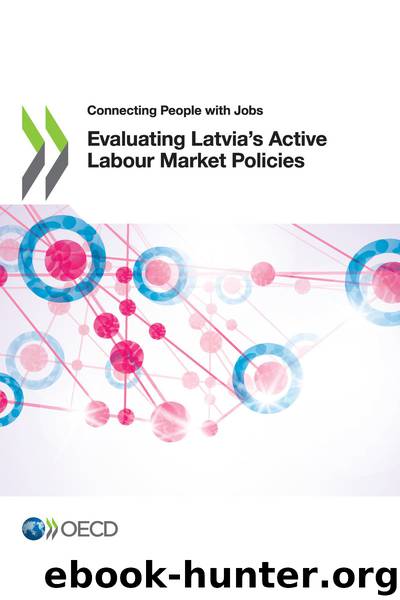Evaluating Latvia’s Active Labour Market Policies by OECD

Author:OECD
Language: eng
Format: epub
Tags: employment
Publisher: OECD Publishing
Published: 2019-04-16T00:00:00+00:00
Box 3.4. Heterogeneous effects of training in the existing literature
Linking the sub-group analysis presented in this chapter with sub-group analysis in the existing literature faces two main challenges. First, most existing meta-analyses and systematic reviews consider how programme-level treatment effects differ, rather than considering whether treatment effects differ for certain sub-groups within in a given programme. For example, rather than comparing women and men treated by mixed-gender programmes, such meta-analyses and systematic reviews compare mixed-gender programmes, with all-women and all-men programmes. Second, the sub-groups on which previous meta-analyses – and individual studies – have focussed do not necessarily match the sub-groups on which this chapter focusses. For example, it is rare for studies to break down the results according to social assistance receipts, as in this chapter.
Despite these challenges, some comparisons between the sub-group results in this chapter and the existing literature are possible: participant gender has been a special focus of many previous studies. There is some limited evidence suggesting that training may be more effective for women than men, but much of the existing literature finds any gender differences to be small and not statistically significant. At the programme level, the updated analysis by Card et al. (forthcoming[46]), has found that female-only training (and other ALMP) programmes outperform male-only and mixed programmes, but this finding is not replicated in similar studies by Kluve et al. (2016[49]) and Vooren et al. (2018[48]). Similarly, looking at differential effects by gender within a collection of mixed-gender training programmes in developing countries, McKenzie (2017[52]) finds no clear evidence that women benefit more than men. Nevertheless, previous work on training in Latvia has found similar results to this chapter. In particular, Hazans and Dmitrijeva (2013[38]) show that women experience stronger employment effects from formal training, but men experience stronger employment effects from non-formal training.
Turning to other sub-groups, the evidence on whether younger or older workers benefit more from ALMP measures is somewhat mixed. In a very recent study, Vooren et al. (2018[48]) find that the maximum age of programme participants has no impact on ALMP measures’ effectiveness, just as is observed for non-formal training in this chapter, drawing on a range of studies from a range of OECD and non-OECD countries both within and outside of Europe. However, previous evidence from Kluve (2010[53]) – which focusses solely on studies conducted in Europe – finds that ALMP measures targeting young people are less likely to be effective. Interestingly, Card et al. (forthcoming[46]) demonstrate that, if anything, mixed-age ALMP measures outperform those targeting either young people or older people.
While this chapter does not speak directly to the question of training’s effectiveness for the long-term unemployed, Card et al. (forthcoming[46]) find that the impacts are larger for those programmes that explicitly target those in long-term unemployment. While Card et al.’s estimates are at the programme level rather than the individual level, tentatively, their findings suggest that tailoring the content of the training for long-term unemployed individuals (even after assignment to a training programme) may boost impact.
Download
This site does not store any files on its server. We only index and link to content provided by other sites. Please contact the content providers to delete copyright contents if any and email us, we'll remove relevant links or contents immediately.
Bullshit Jobs by David Graeber(4134)
Radical Candor by Kim Scott(2689)
I Am Right, You Are Wrong by Edward De Bono(2427)
23:27 by H. L. Roberts(2222)
Nomadland by Jessica Bruder(2036)
Average Is Over by Tyler Cowen(1822)
The Conflict Resolution Phrase Book by Barbara Mitchell & Cornelia Gamlem(1753)
Out of Our Minds: Learning to Be Creative by Ken Robinson(1715)
High-Impact Interview Questions by Victoria A. Hoevemeyer(1671)
Who Moved My Cheese?: An Amazing Way to Deal With Change in Your Work and in Your Life by Johnson Spencer(1626)
The Ideal Team Player by Patrick M. Lencioni(1618)
An Everyone Culture: Becoming a Deliberately Developmental Organization by Robert Kegan & Lisa Laskow Lahey(1616)
The Asshole Survival Guide by Robert I. Sutton(1576)
Automatic Society by Bernard Stiegler(1531)
Unleashed by Anne Morriss & Frances Frei(1510)
Who by Street Randy & Smart Geoff(1484)
42 Rules of Employee Engagement by Susan Stamm(1449)
96 Great Interview Questions to Ask Before You Hire by Paul Falcone(1433)
Fish! by Stephen C. Lundin(1374)
